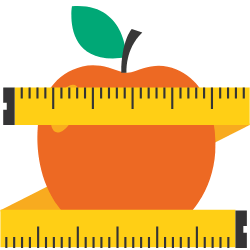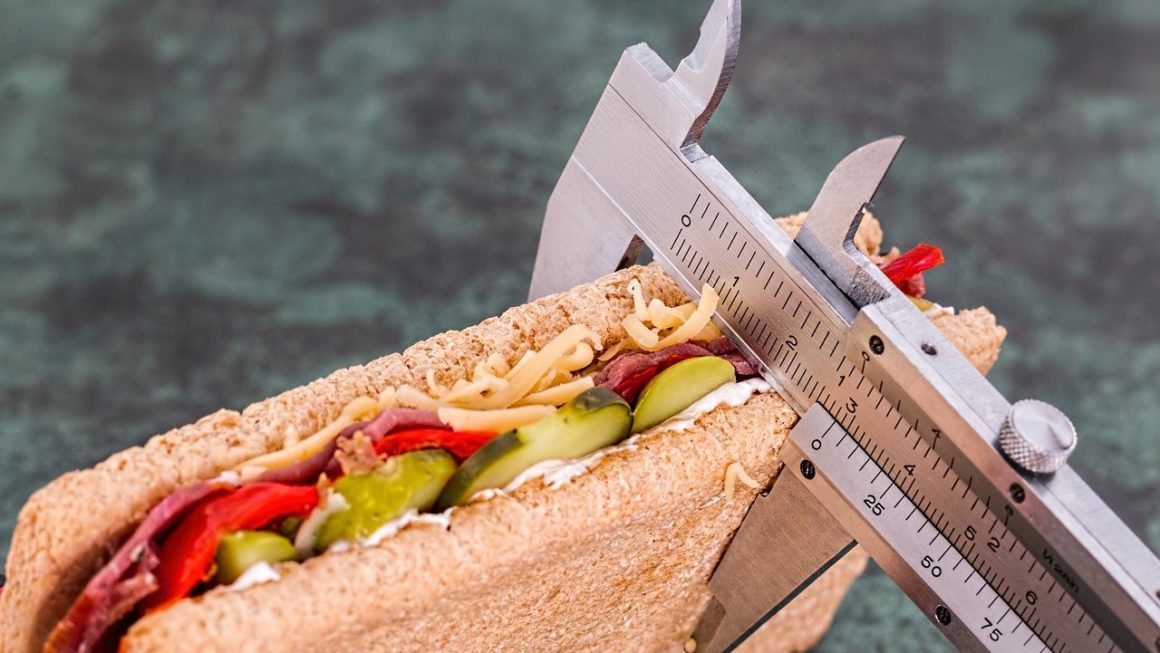The are several ways to calculate your calorie intake. Daily calorie intake is the amount of energy the body needs to function and maintain metabolism. Reducing calories by 15-20% per day leads to weight loss. On the other hand, athletes must increase their daily caloric intake if they wish to gain muscle mass.
You can calculate the calorie rate either using the Harris Benedict formula or determine the average figure using tables. Ultimately, however, the formula does not take into account that a person’s calorie needs always vary from day to day.

Calories per day
The daily calorie intake always depends on gender, weight and the level of physical activity performed by a person on a particular day. In addition, the final goal of losing weight, maintaining existing weight, or gaining muscle mass affects the calculation of the calorie norm.
The average calorie intake per day (for people aged 17-60 years, with a standard body build and with an average level of physical activity) is 2400-2800 kcal for men and 1800-2200 kcal for women. The daily needs of children and adolescents are usually lower.
For a more accurate calculation of the calorie rate, you can use the formulas presented in the material (first of all, the Harris Benedict formula), tables or an online calculator. However, we note that the calculated figure can have a margin of error from 200-300 kcal.
Daily calorie intake:
2400-2800 kcal for men
1800-2200 kcal for women
Calorie Calculation - The Basis of Your Diet
It is important to understand that the calorie rate is only a conditional figure. Both the calculation method itself and the numbers indicated in the calorie tables can vary. It is also worth noting that the absorption of nutrients from food is rarely 100%, and the energy requirements on a particular day may be higher or lower.
The daily calorie intake is only a general guideline for drawing up a diet, while in practice it is more convenient to calculate the consumption rates of PFC’s (proteins, fats and carbohydrates). It’s also important to consider the glycemic index of carbohydrates – how quickly they raise blood sugar.
Calorie Rate Formula
Calculating your daily calorie intake begins with determining your basal metabolic rate (BMR), the energy your body needs to keep going. The figure includes the calorie requirements for brain function, maintaining body temperature, digesting food and other metabolic processes.
At the same time, BMR does not take into account physical activity – and from 20 to 90% of daily calories are spent by the body not on metabolism, but on daily movement. Depending on the level of activity load, an additional activity coefficient (from 1.2 to 1.9) is selected, by which the BMR figure is multiplied.
Harris-Benedict formula
The first version of the formula for calculating calorie intake was introduced in 1919 by anthropological scientists James Arthur Harris and Francis Gano Benedict. To draw up the formula, they studied 239 subjects of different genders and ages with different percentages of body fat. The formula was revised and refined in 1942.
The formula for calculating the base rate of calories:
for men: BMR = 88.36 + (13.4 x weight, kg) + (4.8 x height, cm) – (5.7 x age, years)
for women: BMR = 447.6 + (9.2 x weight, kg) + (3.1 x height, cm) – (4.3 x age, years)
How to use the Calorie Rate Calculator:
- Select the metric system of calculation (“metric”)
- Indicate the number of full years (“age”)
- Enter your gender (“male” – male, “female” – female)
- Enter your height in centimeters (“height”)
- Specify the current weight in kilograms (“current weight”)
- Indicate the level of activity (“sedentary” – sedentary lifestyle, “light activity” – sedentary, “moderate” – active, “very active” – very active)
- Enter Your Name
- Provide email to receive the result
- Click the button to calculate (“calculate”)


Daily calorie intake - tables
If you are a man, you are 30 years old, you work in an office and do strength training three times a week, then the recommendation for your daily calorie intake will be from 2,600 kcal to 3,200 kcal.
Among other things, calories from food are not 100% absorbed at all. For example, for protein foods, the level of protein assimilation does not exceed 50-70% – but this is not taken into account in the figures for the composition and calorie content of the product. As a result, it is better not to try to calculate the daily calorie intake using the formula, but simply by following the basic recommendations.
Daily calorie intake for men:
Age Activity level Calorie intake
17 – 40 years
Low 2400-2600 kcal
Average 2600-2800 kcal
High 3000-3200 kcal
41 – 60 years
Low 2000-2200 kcal
Average 2400-2600 kcal
High 2600-2800 kcal
Over 61 years of age
Low 2000 kcal
Average 2200-2400 kcal
High 2400-2600 kcal
Daily calories for women:
Age Activity level Calorie intake
17 – 40 years
Low 1800-2000 kcal
Average 2000-2200 kcal
High 2200-2400 kcal
41 – 60 years
Low 1600-1800 kcal
Average 1800-2000 kcal
High 2000-2200 kcal
Over 61 years
Low 1600 kcal
Average 1800 kcal
High 2000 kcal
Daily Activity Ratio
The Harris-Benedict Daily Calorie Formula identifies five types of physical activity. Minimum level (no exercises), low level (exercise 1-3 times a week), medium level (3-5 days a week), high level (6-7 times) and very high level (training more often than once a day).
However, it is in the activity coefficient that the key problem of any formula for calculating calories lies. After calculating BMR accurately (for example, 1765 kcal), you need to multiply the figure by your activity coefficient, ranging from 1.2 to 1.9. The final result will be from 2118 kcal to 3354 kcal – a difference of 1236 kcal.
Activity factors when calculating daily calorie needs:
- Minimum activity level – 1.2
- Low activity level – 1.375
- Average activity level – 1.55
- High level – 1.725
- Very high – 1.9
To determine the daily calorie requirement of the body, you need to multiply the BMR corresponding to your gender, age and weight by the activity coefficient. In turn, this ratio is determined based on the level of physical activity on a particular day.
An excess of the daily caloric intake of 200-300 kcal can give an increase in weight by 2.5 lbs every month – or by as much as 30 lbs per year. That is why it is important to learn how to control your appetite – and adequately assess the size of the portions eaten.
What should the calorie content of breakfast, lunch and dinner be in a proper diet? Should breakfast really contain more calories than other meals? Follow the following nutritional advice for maintaining and losing weight.
Calorie content in proper nutrition
Calories are units of measure for the energy contained in food. In physics, one calorie is the amount of heat required to heat a gram of water by 1 ° C. Note that in proper nutrition, calories are measured in thousands – kilocalories or kcal.
On average, the recommended caloric intake for women is 2000 kcal per day, for men – 2500 kcal. A more accurate figure depends on the height, weight and level of daily physical activity of the individual. For example, athletes need up to 3-4 thousand kcal per day.
To maintain a stable weight, nutritionists most often advise adhering to the 400/600/600 rule – the calorie content of breakfast should be 400 kcal, lunch and dinner – 600 kcal each. This allows for two snacks (lunch and afternoon tea) of 200 kcal each
Are Proteins, Fats, and Carbohydrates important?
Despite the importance of maintaining the proportions of proteins, fats and carbohydrates in proper nutrition, the total calorie content plays a more substantial role. In fact, an excess of calories will quickly lead to weight gain, even with a balanced diet in terms of fats, carbs, and proteins.
Breakfast – the most important calories
Studies show that a full breakfast boosts your metabolic rate throughout the day, helping not only control appetite, but also improve the functioning of all body systems. People who eat enough calories at breakfast are less likely to overeat at lunch and dinner.
The recommended breakfast calories are 400 kcal for women and 600 kcal for men. At the same time, proper nutrition implies the use of fruits, oatmeal, eggs and natural yogurt – while pastries, breads, sausages, cold cuts and cereals for breakfast are not desirable.
Second Breakfast
If you eat breakfast early enough, it is okay to have a healthy snack closer to noon – this will help control calories at lunch. The best choices are foods with high fiber content or those containing healthy fats and totaling about 150-200 kcal, such as unsweetened fruit or a handful of nuts.
Also, in a diet for weight loss, berries, chia seeds or flax seeds can be the second breakfast. They have a low-calorie content, but they form a feeling of fullness and are excellent at reducing appetite. Chia and flax seeds can be taken both dry, washed down with water (a tablespoon is enough) or in the form of a smoothie.

Calories for lunch and dinner
In most cases, the calorie content of lunch and dinner should be 500-700 kcal. More often than not, the reason this figure is exceeded is free access to food (for example, a buffet) – which is why it is important to learn to control portion sizes and not refill your plate over and over again.
When it comes to dietary recommendations, the best option for lunch would be a combination of protein sources (meat, chicken, fish) with whole grains and vegetables. Eating more green vegetables for dinner is recommended – cutting back on pasta, sources of starch (like potatoes) and animal fat.
Excessive consumption of fast carbohydrates for dinner is closely associated with disturbances in the production of insulin – provoking the development of diabetes. In addition, the habit of making the biggest meal of the day for dinner (and consuming more than 1000 calories) quickly leads to excess weight.
On the other hand, excess of certain nutrients is associated with metabolic disorders. For example, excessive amounts of fast carbs disrupt insulin production and trigger chronic hunger. In turn, excessive consumption of animal fats is associated with high blood cholesterol levels.
Most often, nutritionists recommend adhering to the 400/600/600 rule – that is, eating 400 kcal for breakfast, 600 kcal for lunch and 600 kcal for dinner. In addition, proper nutrition allows for two snacks of 200 kcal each. If these standards are observed, the ratio of the proteins, fats, and carbs in a diet plays a secondary role.
Which product is the highest in calories?
| Oops, sorry that answer is wrong. Olive oil (133 Cals) contains more calories than butter (108 Cals) and almond butter (98 Cals), but since it is liquid, we tend to consume less of it. Plus, unlike butter, olive oil contains monounsaturated fats, which help reduce high cholesterol, a leading cause of heart disease. | |
| Great, this is the right answer. Olive oil (133 Cals) contains more calories than butter (108 Cals) and almond butter (98 Cals), but since it is liquid, we tend to consume less of it. Plus, unlike butter, olive oil contains monounsaturated fats, which help reduce high cholesterol, a leading cause of heart disease. | |
| Oops, sorry that answer is wrong. Olive oil (133 Cals) contains more calories than butter (108 Cals) and almond butter (98 Cals), but since it is liquid, we tend to consume less of it. Plus, unlike butter, olive oil contains monounsaturated fats, which help reduce high cholesterol, a leading cause of heart disease. |



